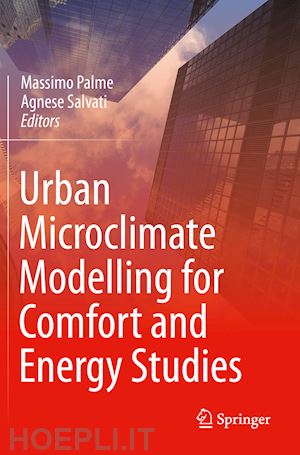
Questo prodotto usufruisce delle SPEDIZIONI GRATIS
selezionando l'opzione Corriere Veloce in fase di ordine.
Pagabile anche con Carta della cultura giovani e del merito, 18App Bonus Cultura e Carta del Docente
This book discusses urban microclimate and heat-related risks in urban areas, brought on by the combination of global climate change effects and local modification of climate determined by extensive urbanization such as the ‘Urban heat island’ phenomenon. This matter is relevant to almost all urbanized areas in the world, where the increase of urban population and air temperature is expected to endanger both the overall health of the population and the energy supply for the functioning of urban systems. The book details the inter-relationship between urban morphology, microclimate and building energy performance and presents a multidisciplinary approach that brings together Urban Climatology, Engineering and Architectural knowledge to support the development of reliable models and tools for research and practice.
This book is a useful tool for architects and building energy modelers, urban planners and geographers who need a practical guide to realize basic urban microclimate simulation for use in both academic research and planning practice.
Chapter 1. Introduction: Anthropocene or Urbanocene? .- Part 1. Urban climate and sustainability: energy performance and thermal comfort in cities .- Chapter 2. The city as a complex thermodynamic system.- Chapter 3. The energetic basis of the urban heat island.- Chapter 4. Outdoor thermal comfort.- Chapter 5. Energy implications of urban microclimate in high latitudes.- Chapter 6. Climate and Energy performance of Mediterranean compact cities.- Chapter 7. Enhancing energy performance and comfort of built environment in tropical climates.- Chapter 8. Urban thermal comfort in arid climates.- Chapter 9. Integrating urban climate knowledge: The need for a new knowledge infrastructure to support climate responsive urbanism.- Part 2. Urban climate modelling and simulation: physics and tools.- Chapter 10. Air circulation in urban areas.- Chapter 11. The coupling of the weather research and forecasting model with the urban canopy models for climate simulations.- Chapter 12. The Urban Weather Generator model: Physics-based microclimate simulation for performance-oriented urban planning.- Chapter 13. The Solene-microclimate model: potentiality for comfort and energy studies.- Chapter 14. Comparing ENVI-met and Grasshopper modelling strategies to assess local climates and urban heat island effect.- Chapter 15. Urban microclimate and building energy simulation coupling techniques.- Chapter 16. RayMan and SkyHelios model.- Chapter 17. A methodology for assessing the impact of climate change on building energy consumption.- Part 3. Applying urban climate modelling in policy, planning and design: case studies.- Chapter 18. Spatial metrics to investigate the impact of urban form on microclimate and building energy performance: an essential overview.- Chapter 19. Green infrastructures to mitigate extreme temperatures in cities.- Chapter 20. Urban morphology as a mitigation strategy of urban warming in oasis cities of arid regions.- Chapter 21. Human biometeorogical models – existing and future reflections for Lisbon.- Chapter 22. Impact of local urban climate on building energy performance: case studies in Mendoza, Argentina.- Chapter 23. Green infrastructure to reduce the energy demand of cities.- Chapter 24. Cool materials for passive cooling in buildings.
Massimo Palme is Materials Engineer and holds a PhD in Architecture, Energy and Environment, and a Professional Degree in Data Science. Currently he is Associate Professor and Director of the Urban and Built Environment Research Lab, Catholic University of the North in Antofagasta, Chile. Since 2006 develops research on the topics of building simulation, sustainability of urban environment, and climate change mitigation and adaptation. President of the Chilean Chapter of the International Building Performance Simulation Association and Secretary of the Chilean Chapter of the International Landscape Ecology Association, Massimo is author of more than 100 publications in Journals, Books and Conference Proceedings. He has been founded by Senescyt in Ecuador and Fondecyt in Chile to develop research projects as principal investigator and he has been visiting researcher at: Sapienza University of Rome, Catania University, National Institute of Renewable Energies and Energy Efficiency of Ecuador, Federal University of Santa Catarina, and Kobe University as Invitational Fellow of the Japanese Society for the Promotion of Science.
Agnese Salvati is an Architectural Engineer with a PhD in “Architecture, Energy and Environment” & “Engineering-based Architecture and Urban Planning” from Polytechnic University of Catalonia (UPC)and Sapienza University of Rome. As a Research Fellow in Resource Efficient Future Cities at the Institute of Energy Futures at Brunel University London, her research work focuses on the interrelationships between urban morphology, urban microclimate and building energy performance. She participated in national and international research projects among which: the IEA EBC Annex 80 on Resilient Cooling of Building, the EPSRC project Urban Albedo, the EU Horizon2020 project ReCO2St, the Spanish national research project M.U.M - Mediterranean Urban Morphology. She was invited as visiting researcher at: the School of Architecture of the Catholic University of the North in Antofagasta, Chile in 2017; the laboratory of Energy Efficiency, Sustainability and Climate Change at the National University of Rosario, Argentina in 2019. She had research appointments at the Low Carbon Building group at Oxford Brookes University, the AiEM -Architecture Energy and Environment research group at the Barcelona School of Architecture (ETSAB) and the SOS Urban Lab at faculty of Faculty of Civil and Industrial Engineering at Sapienza University of Rome.











Il sito utilizza cookie ed altri strumenti di tracciamento che raccolgono informazioni dal dispositivo dell’utente. Oltre ai cookie tecnici ed analitici aggregati, strettamente necessari per il funzionamento di questo sito web, previo consenso dell’utente possono essere installati cookie di profilazione e marketing e cookie dei social media. Cliccando su “Accetto tutti i cookie” saranno attivate tutte le categorie di cookie. Per accettare solo deterninate categorie di cookie, cliccare invece su “Impostazioni cookie”. Chiudendo il banner o continuando a navigare saranno installati solo cookie tecnici. Per maggiori dettagli, consultare la Cookie Policy.